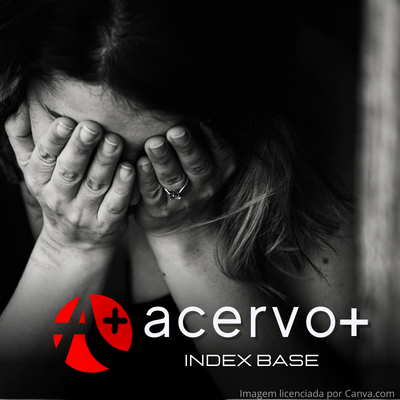Uma abordagem geral do Transtorno de Estresse Pós-Traumático: revisão de literatura
##plugins.themes.bootstrap3.article.main##
Resumo
Objetivo: Analisar as características do Transtorno de Estresse Pós-Traumático (TEPT). Revisão bibliográfica: O TEPT é uma doença psicológica que pode surgir depois que uma pessoa experimenta um ou mais eventos traumáticos, como combate militar, trauma físico devido a lesão ou outros acidentes, como violência doméstica, estupro, trauma de infância, negligência ou abuso. Este se manifesta com sintomas dramáticos de hiperexcitação, lembranças memoriais intrusivas, pesadelos e flashbacks somatossensoriais. É frequentemente acompanhado por comorbidades psiquiátricas, como depressão, abuso de substâncias ou transtornos de ansiedade, o que leva a um alto nível de incapacidade funcional. Considerações finais: O TEPT consiste no desenvolvimento de sintomas relacionados ao estressor após um ou mais eventos traumáticos. Seus sintomas geralmente são classificados em três grupos: intrusão, evitação, e excitação com efeitos preponderantes no sono com insônia e pesadelo. O tratamento farmacológico é feito com Inibidores Seletivos de Recaptação de Serotonina ou Inibidores Seletivos de Recaptação de Norepinefrina, cujos efeitos colaterais são bem tolerados. Nesse sentido, é essencial um diagnóstico precoce e um tratamento multidisciplinar com um médico psiquiatra e um psicólogo a fim de minimizar os impactos do transtorno.
##plugins.themes.bootstrap3.article.details##
Copyright © | Todos os direitos reservados.
A revista detém os direitos autorais exclusivos de publicação deste artigo nos termos da lei 9610/98.
Reprodução parcial
É livre o uso de partes do texto, figuras e questionário do artigo, sendo obrigatória a citação dos autores e revista.
Reprodução total
É expressamente proibida, devendo ser autorizada pela revista.
Referências
2. BIGGS QM, et al. Post traumatic stress symptom variation associated with sleep characteristics. BMC Psychiatry, 2020; 20(1): 174.
3. BOTHE T, et al. How expensive are post-traumatic stress disorders? Estimating incremental health care and economic costs on anonymised claims data. Eur J Health Econ, 2020; 21(6): 917-930.
4. COOKE JE, et al. Prevalence of posttraumatic and general psychological stress during Covid-19: A rapid review and meta-analysis. Psychiatry Res, 2020; 292: 113347.
5. D'ETTORRE G, et al. Post-Traumatic Stress Symptoms in Healthcare Workers Dealing with the Covid-19 Pandemic: A Systematic Review. Int J Environ Res Public Health, 2021; 18(2): 601.
6. FlANAGAN JC, et al. Behavioral Treatments for Alcohol Use Disorder and Post-Traumatic Stress Disorder. Alcohol Res, 2018; 39(2): 181-192.
7. GIOTAKOS O. Neurobiology of emotional trauma. Psychiatriki. 2020; 31(2):162-171.
8. HORI H, KIM Y. Inflammation and post-traumatic stress disorder. Psychiatry Clin Neurosci, 2019; 73(4): 143-153.
9. HOWIE H, et al. A review of epigenetic contributions to post-traumatic stress disorder. Dialogues Clin Neurosci, 2019; 21(4): 417-428.
10. ISMAEL F, et al. Post-infection depressive, anxiety and post-traumatic stress symptoms: A prospective cohort study in patients with mild Covid-19. Prog Neuropsychopharmacol Biol Psychiatry, 2021; 111: 110341.
11. LI Y, et al. Prevalence of depression, anxiety and post-traumatic stress disorder in health care workers during the Covid-19 pandemic: A systematic review and meta-analysis. PLoS One, 2021; 16(3): e0246454.
12. MARCO CA, et al. Post-traumatic stress and stress disorders during the Covid-19 pandemic: Survey of emergency physicians. J Am Coll Emerg Physicians Open, 2020; 1(6): 1594-1601.
13. NISAR S, et al. Genetic and Neuroimaging Approaches to Understanding Post-Traumatic Stress Disorder. Int J Mol Sci, 2020; 21(12): 4503.
14. NOWICKI GJ, et al. The Severity of Traumatic Stress Associated with Covid-19 Pandemic, Perception of Support, Sense of Security, and Sense of Meaning in Life among Nurses: Research Protocol and Preliminary Results from Poland. Int J Environ Res Public Health, 2020; 17(18): 6491.
15. ORSOLINI L, et al. Use of Medicinal Cannabis and Synthetic Cannabinoids in Post-Traumatic Stress Disorder (PTSD): A Systematic Review. Medicina (Kaunas). 2019; 55(9): 525.
16. RAUDENSKÁ J, et al. Occupational burnout syndrome and post-traumatic stress among healthcare professionals during the novel coronavirus disease 2019 (Covid-19) pandemic. Best Pract Res Clin Anaesthesiol, 2020; 34(3): 553-560.
17. RESTAURI N, SHERIDAN AD. Burnout and Posttraumatic Stress Disorder in the Coronavirus Disease 2019 (Covid-19) Pandemic: Intersection, Impact, and Interventions. J Am Coll Radiol, 2020; 17(7): 921-926.
18. SCHONER J, et al. Post-traumatic stress disorder and beyond: an overview of rodent stress models. J Cell Mol Med, 2017; 21(10): 2248-2256.
19. SCHRADER C, ROSS A. A Review of PTSD and Current Treatment Strategies. Mo Med, 2021; 118(6): 546-551.
20. SIMANI L, et al. Prevalence and correlates of chronic fatigue syndrome and post-traumatic stress disorder after the outbreak of the Covid-19. J Neurovirol, 2021; 27(1): 154-159.
21. WEBER FC, WETTER TC. The Many Faces of Sleep Disorders in Post-Traumatic Stress Disorder: An Update on Clinical Features and Treatment. Neuropsychobiology, 2022; 81(2): 85-97.
22. YABUKI Y, FUKUNAGA K. Clinical Therapeutic Strategy and Neuronal Mechanism Underlying Post-Traumatic Stress Disorder (PTSD). Int J Mol Sci, 2019; 20(15): 3614.

